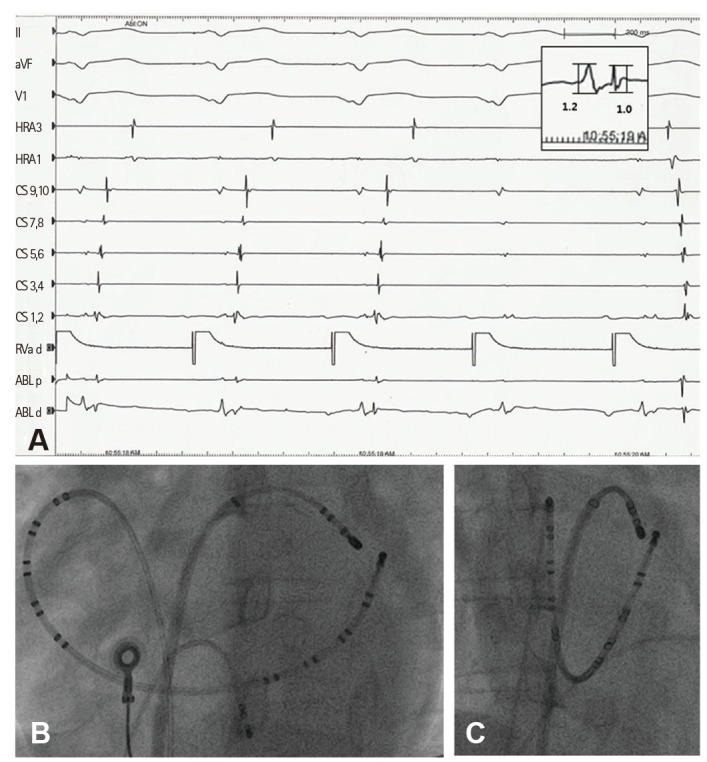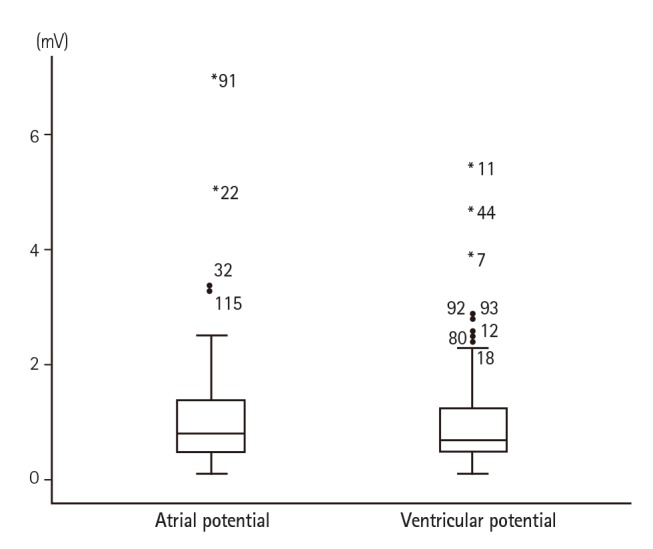Korean Circ J.
2017 Jul;47(4):462-468. 10.4070/kcj.2016.0371.
Local Atrial/Ventricular Ratio as an Adjuvant Marker for Catheter Ablation of Atrioventricular Accessory Pathways
- Affiliations
-
- 1Department of Internal Medicine, Haeundae Paik Hospital, Inje University College of Medicine, Busan, Korea.
- 2Department of Internal Medicine, Busan Paik Hospital, Inje University College of Medicine, Paik Hospital, Busan, Korea. epkimdk@paik.ac.kr
- KMID: 2392883
- DOI: http://doi.org/10.4070/kcj.2016.0371
Abstract
- BACKGROUND AND OBJECTIVES
The earliest atrial (A)/ventricular (V) activation potential, or accessory pathway (AP) potential are commonly used as ablation targets for atrioventricular (AV) APs. However, these targets are sometimes ambiguous.
SUBJECTS AND METHODS
We reviewed 119 catheter ablation cases in 112 patients diagnosed with orthodromic atrioventricular reentrant tachycardia (AVRT) or Wolff-Parkinson-White (WPW) syndrome. Local A/V amplitude potentials with the earliest activation or AP potential were measured shortly before achieving antegrade AP conduction block, ventriculoatrial block during right ventricle (RV) pacing, or AVRT termination with no AP conduction.
RESULTS
APs were located in the left lateral (55.5%), left posterior (17.6%), left posteroseptal (10.1%), midseptal (1.7%), right posteroseptal (7.6%), right posterior (1.7%), and right lateral (5.9%) regions. The mean earliest activation time was 16.7±15.5 ms, mean A/V potential was 1.1±0.9/1.0±0.9 mV, and mean A/V ratio was 1.7±2.0. There was no statistically significant difference between the activation methods (antegrade vs. RV pacing vs. orthodromic AVRT) or AP locations (left vs. right atrium). However, when the local A/V ratio was divided into 3 groups (≤0.6, 1.0±0.3, and ≥1.4), the antegrade approach resulted in an A/V ratio greater than 1.0±0.3 (86.7%, p=0.007), and the orthodromic AVRT state resulted in a ratio of less than 1.0±0.3 (87.5%, p<0.001).
CONCLUSION
The mean local A/V potential and ratio did not differ by activation method or AP location. However, a different A/V ratio based on activation method (≥1.0±0.3, antegrade approach; and ≤1.0±0.3, orthodromic AVRT state) could be a good adjuvant marker for targeting AV APs.
Keyword
MeSH Terms
Figure
Reference
-
1. Chen SA, Tai CT. Ablation of atrioventricular accessory pathways: current technique-state of the art. Pacing Clin Electrophysiol. 2001; 24:1795–1809. PMID: 11817815.2. Liu E, Shehata M, Swerdlow C, et al. Approach to the difficult septal atrioventricular accessory pathway: the importance of regional anatomy. Circ Arrhythm Electrophysiol. 2012; 5:e63–e66. PMID: 22715241.3. Wang L, Yao R. Radiofrequency catheter ablation of accessory pathway-mediated tachycardia is a safe and effective long-term therapy. Arch Med Res. 2003; 34:394–398. PMID: 14602506.4. Dagres N, Clague JR, Kottkamp H, Hindricks G, Breithardt G, Borggrefe M. Radiofrequency catheter ablation of accessory pathways. Outcome and use of antiarrhythmic drugs during follow-up. Eur Heart J. 1999; 20:1826–1832. PMID: 10581141.5. Scheinman M, Calkins H, Gillette P, et al. NASPE policy statement on catheter ablation: personnel, policy, procedures, and therapeutic recommendations. Pacing Clin Electrophysiol. 2003; 26:789–799. PMID: 12698688.6. Page RL, Joglar JA, Caldwell MA, et al. 2015 ACC/AHA/HRS guideline for the management of adult patients with supraventricular tachycardia: executive summary: a report of the American College of Cardiology/American Heart Association task force on clinical practice guidelines and the Heart Rhythm Society. Heart Rhythm. 2016; 13:e92–135. PMID: 26409097.7. Page RL, Joglar JA, Caldwell MA, et al. 2015 ACC/AHA/HRS guideline for the management of adult patients with supraventricular tachycardia: a report of the American College of Cardiology/American Heart Association task force on clinical practice guidelines and the Heart Rhythm Society. Heart Rhythm. 2016; 13:e136–e221. PMID: 26409100.8. Iturralde P, Guevara-Valdivia M, Rodríguez-Chávez L, Medeiros A, Colin L. Radiofrequency ablation of multiple accessory pathways. Europace. 2002; 4:273–280. PMID: 12134973.9. Issa ZF, Miller JM, Zipes DP. Atrioventricular reentrant tachycardia. In : Issa ZF, Miller JM, Zipes DP, editors. Clinical arrhythmology and electrophysiology: a companion to braunwald's heart disease. 2nd ed. Philadelphia: Elsevier Sanders;2012. p. 411–467.10. Han S, Miller JM. Pacemap of delta wave for successful ablation of traumatized atrioventricular accessory pathway. Heart Rhythm. 2012; 9:1321–1323. PMID: 22406146.11. Otomo K, Gonzalez MD, Beckman KJ, et al. Reversing the direction of paced ventricular and atrial wavefronts reveals an oblique course in accessory AV pathways and improves localization for catheter ablation. Circulation. 2001; 104:550–556. PMID: 11479252.12. Morady F. Catheter ablation of supraventricular arrhythmias: state of the art. J Cardiovasc Electrophysiol. 2004; 15:124–139. PMID: 15028093.13. Guo XG, Liu XU, Zhou GB, Ma J, Ouyang F, Zhang S. Frequency of fractionated ventricular activation and atrial/ventricular electrogram amplitude ratio at successful ablation target of accessory pathways in patients with Ebstein's anomaly. J Cardiovasc Electrophysiol. 2015; 26:404–411. PMID: 25546726.14. Haissaguerre M, Fischer B, Warin JF, Dartigues JF, Lemétayer P, Egloff P. Electrogram patterns predictive of successful radiofrequency catheter ablation of accessory pathways. Pacing Clin Electrophysiol. 1992; 15(11 Pt 2):2138–2145. PMID: 1279615.15. Haïssaguerre M, Dartigues JF, Warin JF, Le Metayer P, Montserrat P, Salamon R. Electrogram patterns predictive of successful catheter ablation of accessory pathways. Value of unipolar recording mode. Circulation. 1991; 84:188–202. PMID: 2060095.16. Cappato R, Schlüter M, Mont L, Kuck KH. Anatomic, electrical, and mechanical factors affecting bipolar endocardial electrograms. Impact on catheter ablation of manifest left free-wall accessory pathways. Circulation. 1994; 90:884–894. PMID: 8044960.17. Mont L, Schlüter M, Gürsoy S, Siebels J, Kuck KH. The predictors of success in the radiofrequency ablation of left accessory pathways using the single-catheter technic. Rev Esp Cardiol. 1993; 46:745–751. PMID: 8290777.18. Long DY, Dong JZ, Sang CH, et al. Ablation of left-sided accessory pathways with atrial insertion away from the mitral annulus using an electroanatomical mapping system. J Cardiovasc Electrophysiol. 2013; 24:788–792. PMID: 23581615.
- Full Text Links
- Actions
-
Cited
- CITED
-
- Close
- Share
- Similar articles
-
- A Case of Successful Ablation of Right-Sided Accessory Pathway during Atrial Fibrillation
- Successful Ablation of Resistant Left Lateral Accessory Pathway and Coexisting Atypical Atrioventricular Nodal Reentrant Tachycardia
- Characteristics of Intracardiac Electrogram at Successful Sites of Radiofrequency Catheter Ablation in Patients with Accessory Pathways
- Where We Can Find Bypass Tract in Ebstein's Anomaly?; a Case of Successful Ablation of Bypass Tract in Ebstein's Anomaly
- Left atrial ıntramural hematoma after radiofrequency catheter ablation of left lateral accessory pathway



